Featured Application
Specific prototyping of dental metal crowns and medical implants.
Abstract
The surface condition of the materials involved in dentistry is significant for the subsequent operations that are applied in oral cavity. Samples of Co–Cr–W alloy, obtained through selective laser melting (SLM) 3D printing, with different surface states were analyzed. Surface analysis after the 3D printing process and sandblasting was realized from microstructural, chemical composition, profilometry, droplet adhesion, scratch test, and microhardness perspectives. The results presented a hardening process and a roughness modification following the sandblasting procedure, a better adhesion of the liquid droplets, the appearance of micro-cracks during the scratch test, and the oxidation of the sample after the 3D printing process and surface processing.
Keywords:
3D printing; Co–Cr–W; dental materials; SEM; EDS; scratch test; droplet adhesion; profilometry; microhardness 1. Introduction
Characterized by a remarkable biocompatibility, cobalt-based alloys are widely used in the manufacturing of implants for the hip and knee, elements for immobilizing bone fractures (screws, plates, nails, etc.), and heart valves, and they have numerous applications in dentistry. These alloys can be: Binary (Co–Cr), ternary (Co–Cr–Mo and Co–Cr–Ni) or complex, with a content of approximately 65% Co, 30% Cr, and other elements (W, Ni, Ti, Nb, Si, etc.) in proportions of a maximum of 5%. These alloys belong to the category of stellites (lat. Stella = star), because they are characterized by a metallic luster persistent over time. They were originally produced by Deloro Stellite Company (Kokomo, IN, USA), based on the 1881 invention of Elwood Haynes [1,2,3]. Metal-based biomaterials are extremely important for improving and increasing the impact of implantable devices. Their applications mainly include load-bearing implants (e.g., metallic joints, such as hip), elements for stabilization, clips, wires, needles, plates, and screws, and a special category of dental implants and metal crowns proposed for the rehabilitation of deteriorated bone structure. Metal elements with applications in the field of medicine can be used as replacement elements for deteriorated tissues and in the recovery of soft tissues such blood vessels. The most commonly used metallic biomaterials are based on stainless steels, Co–Cr alloys, and Ti-based alloys. A new class of metal-based materials are biodegradable alloys, such as Mg-, Fe-, and Zn-based alloys. This special class can largely benefit from 3D printing technologies. Other examples of the alloys used in medical field are based on Ta, Nb, and noble materials such as Au- and Ag-based alloys with high percentages of Pt and Au. These materials are typically applied for the realization of dental prostheses such as crowns, dentures, inlays, and bridges [4,5].
Additive manufacturing (AM) was initially performed and developed in the 1980s as a new technique to improve the classical technologies for obtaining materials. In the case of metallic materials, the main property of these techniques (stereo-lithography, fused deposition model, selective electron beam melting, selective laser sintering, selective laser melting, and ink-jet printing) is based on the realization of one layer (different thicknesses) on top of another using a powder. The layers are connected through melting or fusing [6,7]. Based on the definition given by ASTM, the process of AM represents obtaining, layer by layer, metallic elements from a 3D design project as a bottom–top technique of making an element in a different way from the usual approach of melting [8,9,10]. From the different methods of obtaining dental materials based on Co–Cr–W (the tungsten element in Co–Cr alloy ensures increased tensile strength, increased hardness of alloys, and better resistance to corrosion and electro-corrosion [11,12,13]), additive manufacturing using selective laser melting equipment presents very good mechanical behavior [14]. The 3D printing of medical elements can address many of the specific difficulties in obtaining materials with special characteristics in the medical field, such as special structures of different thicknesses and, most importantly, 3D structures. Their surfaces after this CAD design process, at present, still require advanced surface processing, solutions for which are wanted at the industrial (mechanical or chemical) and laboratory (e.g., laser modifications of the surface) levels.
In the field of dentistry, the condition of the surface of metallic elements is very important for the activity undertaken in the oral environment in terms of the interaction between the metallic contact surface and the environment of existing biological solutions. The loss of dental material is higher in the case of higher surface exposure to a liquid. Among other reasons, the condition of the final surface of metallic materials for dentistry applications is important. The final goal of processing is to obtain a product whose execution quality is characterized by the dimensional accuracy of geometric shapes and the level of the surface profile.
This article analyzed the results obtained from the investigation of the surface condition of a metallic material (Co–Cr–W) obtained using 3D additive manufacturing technology (selective laser melting (SLM)). We propose different methods for the surface modification of dental materials that will improve the materials’ behavior in an oral environment. After the CAD design of the final element, solidification was achieved by superimposing some metal powders in layers of 25 and 50 µm, respectively. The condition of the surface after its processing by two mechanical methods (sandblasting) was analyzed by scanning electron microscopy (SEM) in order to characterize the 2D and 3D profiles of the sample. Energy dispersive spectroscopy (EDS) chemical analysis was then conducted in order to characterize the chemical influence of the working processes on the surface. Additionally, profilometry was applied to characterize the roughness profile, while droplet adhesion tests were used in order to observe the hydrophobic character of the surface after the surface processing, and scratch and microhardness tests were carried out for surface hardening characterization.
2. Materials and Methods
2.1. Materials and Techniques
Complex dental problems (determined through computed tomography CT) need new solutions that involve custom items, created via the 3D printing process, in order to obtain specific elements (identified through 3D scanners) (Figure 1). The additive manufacturing technique (i.e., SLM) was used to obtain different samples from Co–Cr–W powders. High-purity metal powders of cobalt, chromium, and tungsten were used for the production through the SLM of the samples. The powder was provided by S&S Scheftner Germany and the 3D printing process was realized using SLM50 equipment (Realizer GmbH, Borchen/ Paderborn, Germany) of the Romanian brand S.C. Lamas Microtech S.R.L. Bucharest.
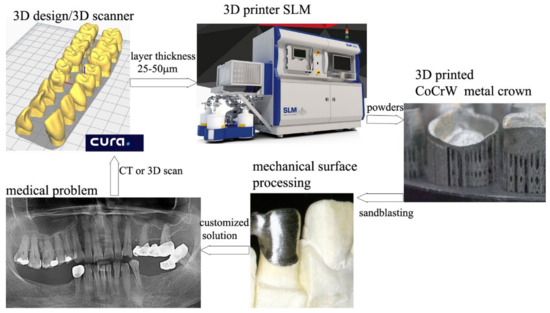
Figure 1.
New solution for complex custom cases for dental configurations, a schematic set-up—with SLM.
The samples were made with different dimensions directly via the 3D printing process (for wettability determinations: 20 × 20 × 2 mm; scratch and profilometry: 30 × 10 × 2 mm; SEM and EDS were carried out before the main tests on the same samples).
Powders were added to the system of the 3D printing equipment, and the thickness of the layer was maintained at a constant value: tlayer = 25 and 50 µm. We obtained six experimental specimens by the additive manufacturing of Co–Cr–W alloy using a laser power of 70 W, a scanning rate of 1000 mm/s, and an exposure time 20 µs. The 3D printed samples had the follow chemical composition (average values from five different areas, wt%): Co: 59.38 (st. dev.: ±1.5), Cr: 25.99 (st. dev.: ±1.1), W: 9.54 (st. dev.: ±0.8), Mo: 3.48 (st. dev.: ±0.5), Si: max. 1.16 (st. dev.: ±0.1), and other elements: 0.43, determined through EDS analysis.
The samples were subject to mechanical preparation of the surfaces using two different sandblasting media. We noted the samples in the article, connected to the solidified layer during the 3D additive manufacturing process as: 25 µm—0 (non-sandblasted initial state), 25 µm—1 (sandblasted with Al2O3 particles), 25 µm—2 (successively sandblasted with Al2O3 and SiO2 particles), which were similar for the 50 µm melted layer as well.
The surface modification of the 3D printed samples was realized by mechanical sandblasting with two different working particles. The sandblasting process was performed with specialized RenfertBasic Eco equipment (Renfert, Hilzingen, Germany), equipped with ceramic nozzles to determine the dimensions of the pulverized material. The alumina particles (Al2O3) had an F100 granulation (dimensions of 100–150 (±5) μm) and a working pressure of p = 3.5–4 bar. The silica particles had diameters between 77–110 (±5) μm and a working pressure of p = 2.5 bar. After they were polished, each sample was ultrasonically cleaned for 30 min in both distilled water and ethanol [15,16].
2.2. Wettability (Contact Angle) Determinations
The contact angles (θc) of electrolyte solution droplets (Hank electrolyte solution, CliniSciences, Nanterre, France) were determined at room temperature (20–25 °C) with drop shape analysis equipment (Kruss, Hamburg, Germany). The protractor was equipped with a KYOWA measuring system and a FAMAS interface analysis system. The camera located above the stage monitored the measuring point, and the moving camera measured the contact angle. The specially designed capillary (with an inner diameter of 5 μm) released a small drop in free fall. Five droplets of electrolyte solution were placed on the experimental metallic surfaces, and the resulting contact angles (θc in °) represent the averages of 10 measurements.
2.3. Microstructural and Chemical Surface Analysis
The surface of the samples was analyzed using a scanning electron microscope (SEM VegaTescan LMH II with an SE detector at 10 mm WD, 30 kV gun power supply, and VegaTC software for 2D and 3D images). The analysis was realized after the cleaning of the sample surface with N2 flux. The chemical composition determinations were made using a Bruker EDS detector (5–6 kcps input signal, 15.5 mm working distance, and Esprit 2.2 software) on five different areas. Because the samples made from 25 and 50 µm layers presented similar results regarding the oxidation or contamination conditions, we have presented the average value of the elements percentages from both samples.
2.4. Profilometry, Scratch Test, and Microhardness
The profilometry was realized using Taylor Hobson FORM TALYSURF I50 equipment (tip: standard conical diamond; analyzed length: 30 mm; Talymap 3D Analysis software). We realized five determinations on each sample and have presented the average values.
Scratching resistance tests were realized using a CETR UMT-2 Tribometer. For the micro-scratch experiment, lamellas of 30 mm in length and 10 mm in width were used. A tip diamond indenter of the Rockwell type with a 120° opening angle at the edge was applied on the metallic 3D printed samples. The standard dimension values of Rockwell’s indenter parameters are: Radius of 200 ± 10 μm; angle of 120° ± 0.35°; deviation from profile of ±2 μm. The software used for the micro-scratch test was the CETR-UMT Test Viewer.
The experiment was based on applying a variable force of 1–20 N over a distance of 35 mm with a 1 mm/s rate on a metallic surface. A normal force (Fz), a lateral force (Fx), and acoustic emission (AE) data were recorded with respect to the test time and the scratch distance during the test. The apparent coefficient of friction (COF) was calculated for each sample. These values are critical for accurately determining the sub-surface and incipient failure of the metallic materials.
A HVT-1000 micro Vickers hardness tester was used to analyze the microhardness of the samples (five determinations were made with a force of 300 gf (2.94 N), a test time of 15 s, and a distance between indentations of approximately 2.5 mm). The equipment had an JVC TK-C92 1EC optical camera and an eyepiece for fine adjustment of 40×.
3. Results and Discussion
The state of a metal surface is represented by a multitude of parameters: Roughness, defects induced by technological processing, microstructure, the size of the hardened surface layer (affected by internal stresses), physical–mechanical and chemical properties, etc. Surface quality has an important influence on the operating behavior and reliability of metal parts, regardless of their field of use.
3.1. Microstructural Surface State
It is known that the initial powder particles are mostly spherical, and the powder surface is clean and smooth [15]. Herein, the partial molten particles (Figure 2a,d) had more irregular shapes and their sizes were clearly bigger than those of the initial particles. After the evaluation of 100 particles prior to the SLM process, we obtained an average radius size of 12 µm, a minimum size of 6.1 µm, and a maximum size of 20.5, with a standard deviation of 2.6 µm. The circumference of the particles presented an average value of 75 µm (st. dev. 1.6) and a mean area of 468 µm2 (st. dev.: 205). In the case of the semi-molten particles, after SLM, a union phenomenon was exhibited. The average size of the radius was 13.87 µm, with a minimum size of 8.85 µm, a maximum size of 38.63 µm, and a standard deviation of 0.86 µm (for the 25 µm—1 sample); meanwhile, the average size of the radius was 20.83 µm, with a minimum size of 8.41 µm, a maximum size of 89.31 µm, and a standard deviation of 15.27 µm (for the 50 µm—1 sample).
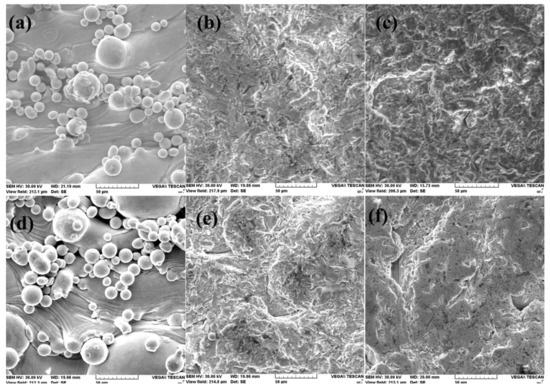
Figure 2.
Scanning electron microscopy (SEM) (2D) images of the surface of the 3D printed samples at 1000×: (a) 25 µm—0, (b) 25 µm—1, (c) 25 µm—2, (d) 50 µm—0, (e) 50 µm—1, and (f) 50 µm—2.
The big dimensions and irregularities of the semi-melted particles in most of the printing strategies negatively impacted the powder melting and layer-by-layer coating [17].
This aspect, i.e., the surface of the material after 3D printing, is important for the selective laser melting process because this technique requires the melting of a powder layer (of a specific thickness) and recoating of this layer with a new one, up to hundreds of layers. The surface parameters of the melted powders must be strictly controlled due to their influence on the particle flux, which affects the laser consolidation [18]. For the semi-melted particles from the surface, a reduction in the number of attached parts of the particles can be observed in the main particles (Figure 2a,d).
After the sandblasting process, all of the particles remaining on the surface after SLM were removed (Figure 2b,c,e,f). The surfaces presented different roughnesses and aspects after the sandblasting process. The 3D images (Figure 3) confirm the results observed from the 2D images and present the aspects of the unified powders after SLM and the new roughnesses after the sandblasting process.
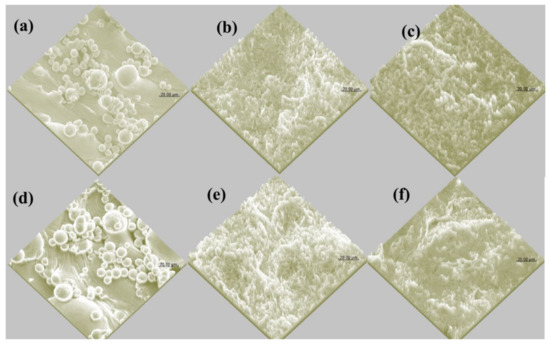
Figure 3.
SEM (3D) images of the surface of the 3D printed samples at 1000×: (a) 25 µm—0, (b) 25 µm—1, (c) 25 µm—2, (d) 50 µm—0, (e) 50 µm—1, and (f) 50 µm—2.
The structural and dimensional analyses show that the semi-melted particles remaining on the surface after the selective melting fabrication process are quite different from the initial powders in terms of size and appearance, and likely metallurgical characteristics as well, taking in consideration the high rate of cooling of the melted powder layers; however, no microstructural analyses were made in this article to confirm this.
3.2. Chemical Composition Determination
The chemical composition of the powders was determined through EDS: Co: 59; Cr: 25; W: 9.5; Mo: 3.50; Si: max. 1; other elements: max. 1.5 (wt%). Except for the presence of oxygen and carbon on the surface, no other elements were identified on the experimental materials after the SLM process (Table 1). The experimental results were obtained as averages of the values determined on five areas of 25 µm—0 (1, 2) and five areas of 50 µm—0 (1, 2). A greater oxidized surface was determined on the sample sandblasted only with alumina, while a smaller percentage of O was found on the surface of the sample processed with alumina and silica powders [19]. The growth and quality of a chromium oxide layer are extremely important for the high resistance to corrosion characteristics of Co–Cr-based alloys. The corrosion of Cr-based materials is based on the growth of a compact Cr oxide film (Cr2O3) or chromium-rich oxides, which act as a jam between the environment (oxidizing atmosphere) and the alloy. Frequently, the value of the corrosion resistance of these alloys depends on the properties of the Cr oxide formed [20].

Table 1.
Chemical composition results of the experimental surface (average of 10 determinations).
After sandblasting with alumina and alumina with silica, the metallic surface was contaminated with alumina and silica parts. On the surface worked with Al2O3+SiO2, no more carbon was identified based on the removal of the carbon compounds left behind by the SLM process (Figure 4).
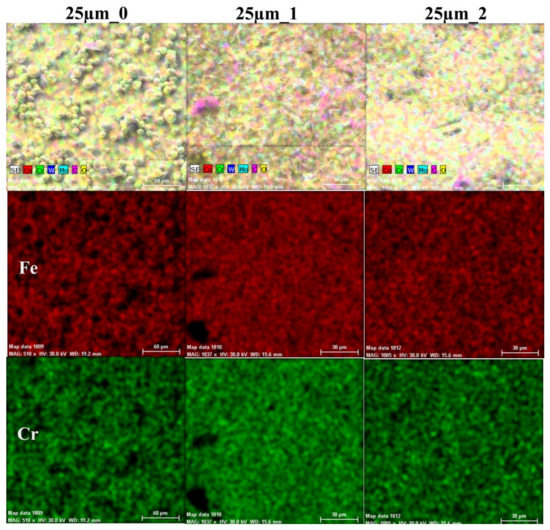
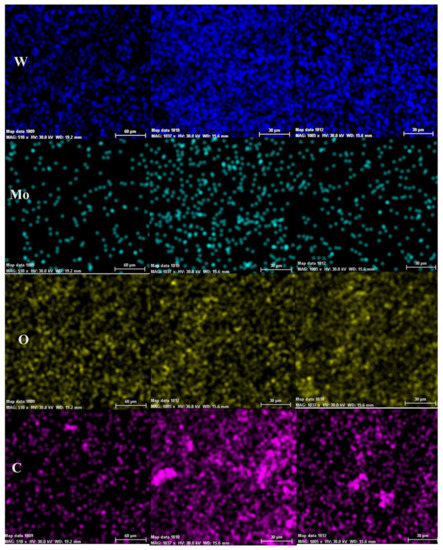
Figure 4.
Elemental distributions (using an EDS detector) of the main elements determined on the experimental surfaces: All elements, Co, Cr, W, Mo, O, and C.
The elemental distributions (made with an EDS detector on 25 µm—0 (1, 2)) of the main elements (Figure 4) determined using the experimental surfaces were in accordance with the chemical composition determinations presented in Table 1. All of the surfaces were covered with oxides and a reduced number of carbon-based compounds.
As a general observation in the literature, 3D printed materials typically present a certain oxidation state after the SLM process, and the surface is generally contaminated with particles of alumina and silica during the sandblasting process. A final cleaning stage using alcohol is recommended after the sandblasting operation.
3.3. Profilometry
The state of a surface, for two materials placed in contact, is critical for the friction between them based on the specific comportment at the micro-scale of each metallic or non-metallic material. The surface profile is also important for the further deposition of a new material on top of the substrate.
The samples presented different profiles of the surface based on the processing mechanism applied (Figure 5). All of the samples exhibited a similar surface, with heights between 0.01 and 20 µm for most of them, and only a few peaks between 20 and 70 µm. The average roughness (Ra center line average (CLA)) was between 4.20 (sample 25 µm—2) and 8.77 µm (sample 50 µm—0), which influenced the friction coefficient, microhardness, and the wear resistance of the materials [21]. The average amplitude in the height direction (Rq) was also big for the 50 µm—0 (11.08 µm) sample and smallest for the 25 µm—2 (5.48 µm) sample, which had the smoothest surface (Table 2).
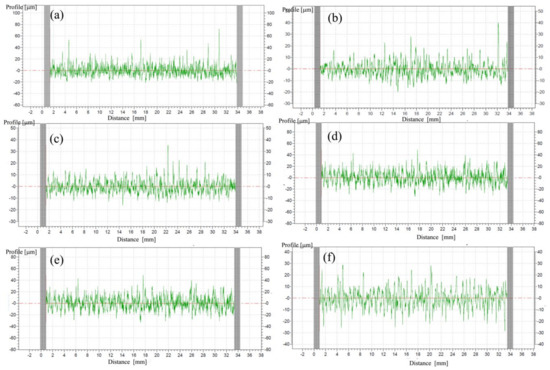
Figure 5.
Profilometry of the surfaces of the samples: (a) 25 µm—0, (b) 25 µm—1, (c) 25 µm—2, (d) 50 µm—0, (e) 50 µm—1, and (f) 50 µm—2.

Table 2.
The main profilometry parameters of the experimental elements.
In order to evaluate a surface state in the height direction, two parameters were used: Rsk and Rku (skewness and kurtosis). The value of the Rsk parameter indicates how a solid material is arranged as a profile of the surface and, in this case, all of the samples presented a positive skewness parameter, that is, the mean of the solid material was mostly below the mean line. The profiles characterized by high peaks, or at which the depression was gentle, had positive skewness parameter values.
Another characteristic of a surface is the kurtosis parameter (Rku), which depends on the form of the profile. All of the surfaces of the samples had an Rku parameter bigger than 3 (except the 50 µm—1 sample, which was Rku = 3.05, meaning that the profile had relatively few high peaks and depressions, such as a platykurtic profile) (Table 2). This is the case of profiles with many high peaks and deep valleys (leptokurtic profile type). The Rp, Rv, and RT parameters confirm that the samples sandblasted with Al2O3 and SiO2 presented the smoothest surface, and the biggest profile differences were found for the 25 µm—0 sample, while the smallest was found for the 25 µm—2 sample (the finest surface).
It is known that surfaces with a high roughness (lower quality) have a low fatigue resistance, while surfaces with a low roughness (high quality) have better fatigue resistance, as well as high resistance to corrosion. This does not mean that the over-finishing of surfaces, at the end of which a very low roughness is obtained, will always be beneficial to the normal operation of the parts and will not only generate an unjustified increase in their cost price.
There are numerous studies that have shown the dependence between the technological stages of processing and the quality of the surface obtained [22,23]. The electro-mechanical characteristics of the equipment used, the type of cutting tools used, the values of the working parameters adopted, and the nature of the coolants used represent specific technological factors that will exert their influence on the final roughness of machined parts. It is important to note that correlations can be made between the properties of the surface layer and the behavior of metal parts under the imposed operating conditions.
3.4. Wettability
Wettability is important because it accompanies all of the processes that take place at the gas–liquid–solid interfaces for all types of elements used in the medical field. If a metallic material is combined with a liquid, there is a tendency to form a protective liquid boundary layer that physically adheres to the surface of the metal. The protection also refers to the decrease in the corrosion intensity in the area of the boundary layer, which leads to a longer operation and to the preservation of the working dimensions of the functional parameters for a longer time. As the surface roughness increases (in the case of samples without mechanical surface processing), the solution droplets come into contact only with the surface peaks (its roughness), thereby decreasing the solid–liquid contact surface [24]. This phenomenon leads to the formation of an additional liquid–environment interface to complete the total liquid–metal interface, i.e., a decrease in the contact surface and implicitly of the metal corrosion [25]. The following average values of the contact angle for the samples were obtained from the determinations: 25 µm—0: 105° (±0.75°), 25 µm—1: 94° (±0.90°), and 25 µm—2: 72.25° (±1.05°); 50 µm—0: 112.5° (±0.70°), 50 µm—1: 101° (±0.90°), and 50 µm—2: 63.5° (±1.1°).
The experimental results presented in the literature have shown that an increased surface roughness decreases the dispersion percentage of liquid droplets [26]. The contact diffusion between the surface roughness and the experimental liquid droplet is shown in Figure 6, including the contact of a droplet with the surface of 25 (50) µm—0, which is a highly rough plane, of 25 (50) µm—1, which is a slightly rough plane, and of 25 (50) µm—2, which is a smooth plane.
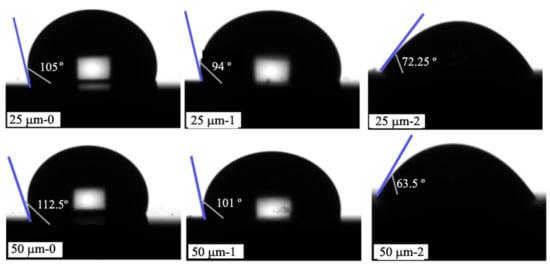
Figure 6.
Wettability of the samples.
A smooth area will not realize any resistance toward a droplet, so it will quickly spread; in contrast, a rough area in contact with a droplet with the presence of air between the peaks will prevent dispersion. A higher roughness with more pits and valleys will store more air/voids and the layer of air will be stronger against liquid dispersion.
If the contact angle of the liquid with metal is high, the liquid will not form an adhesive film on the metal surface, no matter how fast the liquid moves (even at very low rates), so solid surfaces are exposed to both corrosion and erosion phenomena. The layer, depending on its thickness, protects the metal walls from the shock caused by solid particles that move with the biological liquid environment and also has a protective role for all types of dynamic aggression. Depending on the nature of the liquid with which it comes into contact (its chemical composition), corrosion phenomena may occur, but they will have a higher intensity than when combined with erosion phenomena. If the contact angle between the metal parts and the liquid (biological environment) is high, the liquid moistens the surface of the metal material and does not form a protective layer; meanwhile, if the contact angle is small, the liquid slides on the metal and forms a protective boundary layer [24].
For sanded surfaces with a low roughness (25 and 50 µm—2), the hydrophobic character of the surface at the electrolyte drops becomes hydrophilic (Figure 6), with the possibility of forming a protective boundary layer.
3.5. Hardness Analysis
The value of hardness is generally the value of the resistance of a material to the hard contact of another object. Hardness means the resistance of a material to cutting, friction, scratches, indentation, and permanent deformation [27,28]. This means that the surface of the material deforms permanently with a certain degree of impact.
The experimental setup in order to perform an increasing loading force for the scratch test was realized by a pin that was passed over the material surface with a linearly growing load up to the fracture point. On the surface, normal (Fz) and lateral (Fx) action were registered as functions of time or scratch distance (the tests were realized with 1 mm/s), pending the experiment. Along with these forces, AE data were registered and the coefficient of friction (COF) was calculated and plotted against the scratch length (mm). These parameters are important for the surface wear behavior and the initiation of material failure.
The Fx, COF, and AE were plotted against the scratch length (Figure 7) after performing the ʺin lineʺ scratch test on the 3D printed samples.
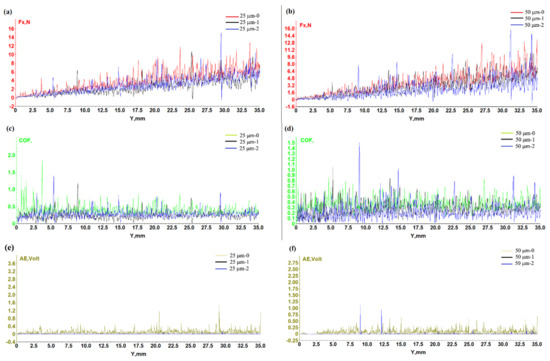
Figure 7.
Scratch test results lateral force (Fx) (f) distance: (a) 25 µm and (b) 50 µm; coefficient of friction (COF) (f) distance: (c) 25 µm and (d) 50 µm; acoustic emission (AE) (f) distance: (e) 25 µm and (f) 50 µm.
The lateral force Fx applied to the samples presented a similar variation with distance behavior for all cases (Figure 7a,b), with slightly higher values for the 50 µm—0 (1, 2) samples based on their higher roughness. A few force peaks were observed for the 25 (50) µm—0 (1, 2) samples when harder surfaces were involved.
The apparent COF (can be extracted from: Fx = COF Fz) variations were similar for all of the samples, with a few peaks along the entire length of the scratch due to the particles being semi-melted and the presence of overlapped material Figure 7c,d. Slightly higher COF values for the initial samples were observed for both experimental sets. The determination of the COF and lateral force (Fx) indicated the presence of a critical load that was correlated with the AE signal. Here, the critical load represents the minimum load when the first crack occurs. In this case, there was no deposited layer to crack and the appearance of cracks was only locally determined for the initial samples by the deformation of semi-melted particles.
AE (occasionally named stress wave emission) presented variations over distance (Figure 7e,f) only for the initial state samples (25 (50) µm—0), where the samples had semi-melted powders (particles) and, during forced contact with the indentor, the variations in AE behavior represent the elastic waves generated during the release of energy internally stored in the material structure. When a scratch resistance limit of the surface through which it yields is reached, spontaneous explosions occur with known waves as a result of the formation and propagation of micro-cracks. Micro-fissures originate in surface notches when local stresses exceed the fracture stress of the material [29,30]. The heights of the AE evolution with distance represent micro-crack formation, and, on initial samples, most of them represent cracks and deformations of the semi-melted particles. For the sandblasted surface samples, only a few peaks of AE were observed in the case of the 50 µm—2 samples at 9 and 12.5 mm of the scratch length, and also at the end of the scratch (Figure 7f).
Based on the exceptional properties of the hardness and wear resistance, Co–Cr-based materials (ASTM F75, F90, F562, and F1537) are the proper choice for medical applications, where friction and sliding to other rough elements is necessary. Among biomedical materials, these ones present high hardness and very good wear resistance (300–400 HV) [27,31]. Nevertheless, the wear resistance characteristics of Co–Cr alloys strictly depend on their microstructure and the processes used to obtain/work them. For 3D printed samples, it is important that they behave as per their usual obtained alloy (made by casting) or even better in order to be used for similar applications.
The traces made on the surface of the material by scratch tests (Figure 8) present a deformation of the material under the Fz force with a flattening of semi-melted particles (Figure 8a,b) in the case of the initial surface. Moreover, micro-cracks were observed in the deformed powders on the scratch surface (Figure 8b), and the material was oriented in the scratch direction.
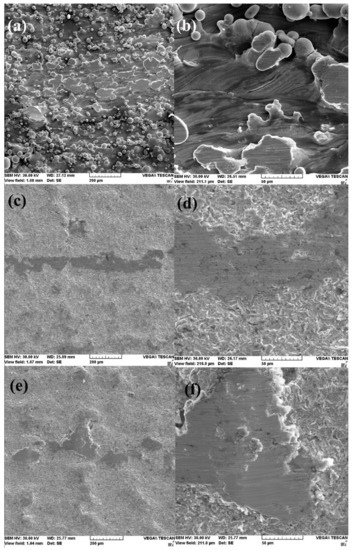
Figure 8.
SEM images of the scratch surface of the (a) and (b) 50 µm—0, (c) and (d) 50 µm—1, and (e) and (f) 50 µm—2 for different amplification powers 500× and 1000×.
The scratch marks decreased as the width of the surface processing increased (Figure 8a,c,e) based on the material response because of the hardening phenomenon, which accompanied the sandblast process. No micro-cracks were observed for the smoother 25 (50) µm—1 and —2 samples (Figure 8d,f) except at the end of the scratch of the 50 µm—2 sample, which confirms the AE results from Figure 7f. For both sandblasted samples, the scratch marks presented interruptions, caused by the surface profilometry and hardness. Material overlap was observed on the surface of the 50 µm—2 samples at higher scratch forces (at the end of the test with a force of 20 N).
The Vickers microhardness results (HV) (Table 3) show a hardening of the surface with the sandblast process in both samples sets. Liu and others identified microhardness (2 N/15 s) of the Co–Cr–W after different heat treatments between 350 and 550 HV [32]. The hardness values obtained from five different locations highlight the differences between the initial surface and the sandblasted surfaces, especially in the case of the first set of samples (25 µm—0 (1, 2)). Different values of the micro Vickers hardness on the same surface were observed for all of the samples based on the presence of semi-melted initial particles and different hardened areas. The values obtained recommend these materials for dental applications as metal crowns [33].

Table 3.
Micro Vickers hardness of the samples.
On the initial 25 µm—0 sample, we observed a value much lower than the other four (378 HV), which was probably taken from a semi-melted particle on the surface. In the case of the 25 µm samples, a high increase in the microhardness was observed with the application of sandblasting, especially for Al2O3+SiO2 solicitation, which supplementarily hardens the surface. For samples made of thicker layers (50 µm), the surface hardening presented smaller differences to the first set (25 µm), which exhibited average values between the minimum and maximum values. The variation of the microhardness on the material surface confirmed the results obtained from scratch tests. Comparing the results of the hardness for the average values, an almost 23% increase was determined for the first set of samples and 3.5% for the second set.
4. Conclusions
Analyzing the results obtained from the surface investigation of some 3D printed metallic samples, we present the follow conclusions:
- After the 3D printing process, the dental material samples made through SLM presented many semi-melted particles that increased the contact surface of the elements. Using different blasting media, the 3D printed alloy surface could be cleaned and its roughness modified in order to fulfill the medical application requirements.
- The oxidation process took place on the surface of all of the samples, and unstable compounds based on sandblast materials were identified.
- The 50 µm—0 (1, 2) presented a higher roughness than the 25 µm—0 (1, 2) sample for the Ra, Rq, and RT parameters, regardless of the condition of the samples’ surfaces.
- The droplet adhesion characteristics were modified with the sandblast operation.
- The sandblast operation considerably increased the samples’ hardness, especially in the case of 25 µm—0 (1, 2).
- Even the material is consecrate in literature, and, in laboratory practice, further medical tests can be considered in order to confirm the implications of surface preparation, especially on 3D complex structures.
Author Contributions
Conceptualization, E.-R.B., C.B., and N.C.; methodology, R.C. and G.Z.; software, R.C. and A.S.; validation, A.M. and A.V.; investigation, N.C., C.B., and E.-R.B.; resources, R.C.; writing—original draft preparation, N.C.; writing—review and editing, R.C. and G.Z.; visualization, A.M.; supervision, N.C. All authors read and agreed to the published version of the manuscript.
Funding
This research was funded by “Grigore T. Popa” University of Medicine and Pharmacy Iași grant number 27500, “Influence of 3D printing/Selective Laser Melting processing parameters on surface quality and bonding level between metal/ceramic components in dental prostheses.” And The APC was funded by “Grigore T. Popa” University of Medicine and Pharmacy Iași.
Institutional Review Board Statement
Not applicable.
Informed Consent Statement
Not applicable.
Acknowledgments
This work was supported by a young-researcher grant from “Grigore T. Popa” University of Medicine and Pharmacy Iași, project number 27500, “Influence of 3D printing/ Selective Laser Melting processing parameters on surface quality and bonding level between metal/ceramic components in dental prostheses.”
Conflicts of Interest
The authors declare no conflict of interest.
References
- Niinomi, M.; Narushima, T.; Nakai, M. Advances in Metallic Biomaterials, Tissues, Materials and Biological Reactions. In Springer Series in Biomaterials Science and Engineering; Springer: Berlin/Heidelberg, Germany, 2015; Volume 3, pp. 157–178. [Google Scholar]
- Wulfman, C.; Koenig, V.; Mainjot, A.K. Wear measurement of dental tissues and materials in clinical studies: A systematic review. Dent. Mater. 2018, 34, 825–850. [Google Scholar] [CrossRef] [PubMed]
- Eakle, S.W.; Kimberly, B. Dental Materials. In Clinical Applications for Dental Assistants and Dental Hygienists, Saunders, 4th ed.; Elsevier: Amsterdam, The Netherlands, 2020; pp. 220–236. [Google Scholar]
- Zeng, L.; Xiang, N.; Wei, B. A comparison of corrosion resistance of cobalt-chromium-molybdenum metal ceramic alloy fabricated with selective laser melting and traditional processing. J. Prosthet. Dent. 2014, 112, 1217–1224. [Google Scholar] [CrossRef] [PubMed]
- Takaichi, A.; Suyalatu, N.T.; Natsuka, J.; Naoyuky, N.; Yusuke, T.; Satoshi, M.; Doi, H.; Kurosu, S.; Chiba, A.; Wakabayashi, N.; et al. Microstructures and mechanical properties of Co-29Cr-6Mo alloy fabricated by selective laser melting for dental application. J. Mech. Behav. Biomed. Mater. 2013, 21, 67–76. [Google Scholar] [CrossRef] [PubMed]
- Van Noort, R. The future of dental devices is digital. Dent. Mater. 2012, 28, 3–12. [Google Scholar] [CrossRef]
- Dikova, T.; Dzhendov, D.; Simov, M.; Katreva-Bozukova, I.; Angelova, S.; Pavlova, D.; Abadzhiev, M.; Tonchev, T. Modern trends in the development of the technologies for production of dental constructions. J. IMAB 2015, 21, 974–981. [Google Scholar] [CrossRef]
- Gu, D. Laser Additive Manufacturing of High-Performance; Springer-Verlag: Berlin/Heidelberg, Germany, 2015; pp. 15–71. [Google Scholar]
- Bandyopadhyay, A.; Bose, S.; Das, S. 3D printing of biomaterials. MRS Bulletin 2015, 40, 108–115. [Google Scholar] [CrossRef]
- Torabi, K.; Farjood, E.; Hamedani, S.H. Rapid prototyping technologies and their applications in prosthodontics, a review of literature. J. Dent. 2015, 16, 1–9. [Google Scholar]
- Lu, Y.; Lin, W.; Xie, M.; Xu, W.; Liu, Y.; Lin, J.; Yu, C.; Tang, K.; Liu, W.; Yang, K.; et al. Examining Cu content contribution to changes in oxide layer formed on selective-laser-melted CoCrW alloys. Appl. Surf. Sci. 2019, 464, 262–272. [Google Scholar] [CrossRef]
- Wang, D.; Ye, G.; Dou, W.; Zhang, M.; Yang, Y.; Mai, S.; Liu, Y. Influence of spatter particles contamination on densification behavior and tensile properties of CoCrW manufactured by selective laser melting. Opt. Laser Technol. 2020, 121, 105678. [Google Scholar] [CrossRef]
- Ho, L.W.; Jung, K.-H.; Hwang, S.-K.; Kang, S.-H.; Kim, D.-K. Microstructure and mechanical anisotropy of CoCrW alloy processed by selective laser melting. Mater. Sci. Eng. A 2019, 749, 65–73. [Google Scholar]
- Padrós, R.; Punset, M.; Molmeneu, M.; Velasco, A.B.; Herrero-Climent, M.; Rupérez, E.; Gil, F.J. Mechanical Properties of CoCr Dental-Prosthesis Restorations Made by Three Manufacturing Processes Influence of the Microstructure and Topography. Metals 2020, 10, 788. [Google Scholar]
- Baciu, A.M.; Bejinariu, C.; Corǎbieru, A.; Mihalache, E.; Lupu-Poliac, M.; Baciu, C.; Baciu, E.R. Influence of process parameters for Selective Laser Melting on the roughness of 3D printed surfaces in Co-Cr dental alloy powder. IOP Conf. Ser. Mater. Sci. Eng. 2019, 572, 012054. [Google Scholar] [CrossRef]
- Bernevig-Sava, M.A.; Stamate, C.; Lohan, N.-M.; Baciu, A.M.; Postolache, I.; Baciu, C.; Baciu, E.-R. Considerations on the surface roughness of SLM processed metal parts and the effects of subsequent sandblasting. IOP Conf. Ser. Mater. Sci. Eng. 2019, 572, 012071. [Google Scholar] [CrossRef]
- Spierings, A.B.; Herres, N.; Levy, G. Influence of the particle size distribution on surface quality and mechanical properties in AM steel parts. Rapid Prototyp. J. 2011, 17, 195–202. [Google Scholar] [CrossRef]
- Tan, J.H.; Wong, W.L.E.; Dalgarno, K.W. An overview of powder granulometry on feedstock and part performance in the selective laser melting process. Addit. Manuf. 2017, 18, 228–255. [Google Scholar] [CrossRef]
- Wang, D.; Wu, S.; Fu, F.; Mai, S.; Yang, Y.; Liu, Y.; Song, C. Mechanisms and characteristics of spatter generation in SLM processing and its effect on the properties. Mater. Des. 2017, 117, 121–130. [Google Scholar] [CrossRef]
- Dorcheh, A.S.; Schütze, M.; Galetz, C.M. Factors affecting isothermal oxidation of pure chromium in air. Corros. Sci. 2018, 130, 261–269. [Google Scholar] [CrossRef]
- Hong, M.-H.; Min, B.K.; Kwon, T.-Y. The Influence of Process Parameters on the Surface Roughness of a 3D-Printed Co–Cr Dental Alloy Produced via Selective Laser Melting. Appl. Sci. 2016, 6, 401. [Google Scholar] [CrossRef]
- Wei, C.; Luo, L.; Wu, Z.; Zhang, J.; Su, S.; Zhan, Y. New Zr-25Ti-xMo alloys for dental implant application: Properties characterization and surface analysis. J. Mech. Behav. Biomed. 2020, 111, 104017. [Google Scholar]
- Pasang, T.; Lees, S.; Takahashi, M.; Fujita, T.; Conor, P.; Tanaka, K.; Kamiya, O. Machining of dental Alloys: Evaluating the surface finish of laterally milled Co-Cr-Mo Alloy. Procedia Manuf. 2017, 13, 5–12. [Google Scholar] [CrossRef]
- Qin, L.; Wu, H.; Guo, J.; Feng, X.; Dong, G.; Shao, J.; Zeng, Q.; Zhang, Y.; Qin, Y. Fabricating hierarchical micro and nano structures on implantable Co-Cr-Mo alloy for tissue engineering by one-step laser ablation. Colloid Surf. B. 2018, 161, 628–635. [Google Scholar] [CrossRef] [PubMed]
- Zhang, Z.Y.; Gu, Q.M.; Jiang, W.; Zhu, H.; Xu, K.; Ren, Y.P.; Xu, C. Achieving of bionic super-hydrophobicity by electrodepositing nano-Ni-pyramids on the picosecond laser-ablated micro-Cu-cone surface. Surf. Coat. Technol. 2019, 363, 170–178. [Google Scholar] [CrossRef]
- Rupp, F.; Gittens Rolando, A.; Lutz, S.; Marmur, A.; Boyan, B.D.; Schwartz, Z.; Geis-Gerstorfer, J. A review on the wettability of dental implant surfaces I: Theoretical and experimental aspects. Acta Biomater. 2014, 10, 2894–2906. [Google Scholar] [CrossRef] [PubMed]
- Kuncická, L.; Kocich, R.; Lowe, T.C. Advances in metals and alloys for joint replacement. Prog. Mater. Sci. 2017, 88, 232–280. [Google Scholar] [CrossRef]
- Hong, J.H.; Yeoh, F.Y. Mechanical properties and corrosion resistance of cobalt-chrome alloy fabricated using additive manufacturing. Mater. Today Proc. 2020, 29, 196–201. [Google Scholar] [CrossRef]
- McGrory, B.J.; Ruterbories, J.M.; Pawar, V.D.; Thomas, R.K.; Salehi, A.B. Comparison of surface characteristics of retrieved cobalt-chromium femoral heads with and without ion implantation. J. Arthroplast. 2012, 27, 109–115. [Google Scholar] [CrossRef]
- Ratner, B.D.; Hoffman, A.S.; Schoen, F.J.; Lemons, J.E. Biomaterials Science: An Introduction to Materials in Medicine; Academic Press: Cambridge, MA, USA, 2004. [Google Scholar]
- Paleu, V.; Gurau, G.; Comaneci, R.I.; Sampath, V.; Gurau, C.; Bujoreanu, L.G. A new application of Fe-28Mn-6Si-5Cr (mass%) shape memory alloy, for self-adjustable axial preloading of ball bearings. Smart Mater. Struct. 2018, 27, 075026. [Google Scholar] [CrossRef]
- Lu, Y.; Zhao, W.; Yang, C.; Liu, Y.; Xiang, H.; Yang, K. Improving mechanical properties of selective laser melted Co29Cr9W3Cu alloy by eliminating mesh-like random high-angle grain boundary. Mater. Sci. Eng. A 2020, 793, 139895. [Google Scholar] [CrossRef]
- Cicciu, M.; Fiorillo, L.; D’Amico, C.; Gambino, D.; Amantia, E.M.; Laino, L.; Crimi, S.; Campagna, P.; Bianch, A.; Herford, A.S.; et al. 3D Digital Impression Systems Compared with Traditional Techniques in Dentistry: A Recent Data Systematic Review. Materials 2020, 13, 1982. [Google Scholar] [CrossRef]
Publisher’s Note: MDPI stays neutral with regard to jurisdictional claims in published maps and institutional affiliations. |
© 2020 by the authors. Licensee MDPI, Basel, Switzerland. This article is an open access article distributed under the terms and conditions of the Creative Commons Attribution (CC BY) license (http://creativecommons.org/licenses/by/4.0/).